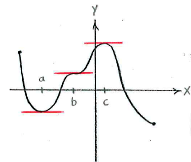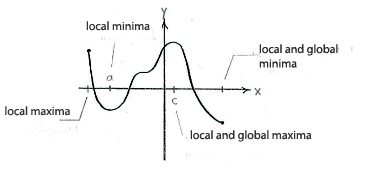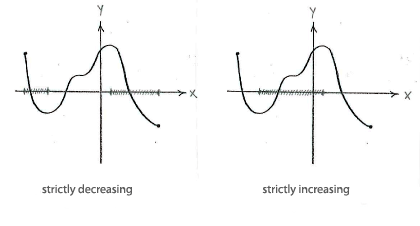Lösung 1.3:1c
Aus Online Mathematik Brückenkurs 2
K (Lösning 1.3:1c moved to Solution 1.3:1c: Robot: moved page) |
|||
| Zeile 1: | Zeile 1: | ||
| - | + | The function has zero derivative at three points, | |
| - | < | + | <math>x=a</math>, |
| - | + | <math>x=b</math>and | |
| - | + | <math>x=c</math> | |
| - | < | + | (see picture below), which are therefore the critical points of the function. |
| - | + | ||
| - | + | ||
| - | < | + | |
| - | + | ||
[[Image:1_3_1_c1.gif|center]] | [[Image:1_3_1_c1.gif|center]] | ||
| + | |||
| + | The point | ||
| + | <math>x=b</math> | ||
| + | is an inflexion point because the derivative is positive in a neighbourhood both the left and right. | ||
| + | |||
| + | At the left endpoint of the interval of definition and at | ||
| + | <math>x=c</math>, the function has local maximum points , because the function takes lower values at all points in the vicinity of these points. At the point | ||
| + | <math>x=a</math> | ||
| + | and the right endpoint, the function has local minimum points. | ||
| + | |||
| + | Also, we see that | ||
| + | <math>x=c</math> | ||
| + | is a global maximum (the function takes its largest value there) and the right endpoint is a global minimum. | ||
| + | |||
| + | |||
[[Image:1_3_1_c2.gif|center]] | [[Image:1_3_1_c2.gif|center]] | ||
| + | |||
| + | Between the left endpoint and | ||
| + | <math>x=a</math>, as well as between | ||
| + | <math>x=c</math> | ||
| + | and the right endpoint, the function is strictly decreasing (the larger | ||
| + | <math>x</math> | ||
| + | is, the smaller | ||
| + | <math>f\left( x \right)</math> | ||
| + | becomes), whilst the function is strictly increasing between | ||
| + | <math>x=a</math> | ||
| + | and x=c (the graph flattens out at | ||
| + | <math>x=b</math>, but it isn't constant there). | ||
| + | |||
| + | |||
[[Image:1_3_1_c3.gif|center]] | [[Image:1_3_1_c3.gif|center]] | ||
Version vom 09:22, 15. Okt. 2008
The function has zero derivative at three points, \displaystyle x=a, \displaystyle x=band \displaystyle x=c (see picture below), which are therefore the critical points of the function.
The point \displaystyle x=b is an inflexion point because the derivative is positive in a neighbourhood both the left and right.
At the left endpoint of the interval of definition and at \displaystyle x=c, the function has local maximum points , because the function takes lower values at all points in the vicinity of these points. At the point \displaystyle x=a and the right endpoint, the function has local minimum points.
Also, we see that \displaystyle x=c is a global maximum (the function takes its largest value there) and the right endpoint is a global minimum.
Between the left endpoint and \displaystyle x=a, as well as between \displaystyle x=c and the right endpoint, the function is strictly decreasing (the larger \displaystyle x is, the smaller \displaystyle f\left( x \right) becomes), whilst the function is strictly increasing between \displaystyle x=a and x=c (the graph flattens out at \displaystyle x=b, but it isn't constant there).



